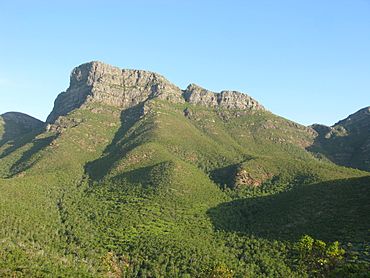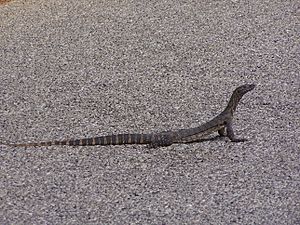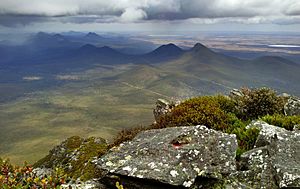Stirling Range National Park facts for kids
Quick facts for kids Stirling Range National ParkWestern Australia |
|
|---|---|
|
IUCN Category II (National Park)
|
|

|
|
| Nearest town or city | Cranbrook |
| Established | 1913 |
| Area | 1,159.2 km2 (447.6 sq mi) |
| Managing authorities | Department of Parks and Wildlife |
| Website | Stirling Range National Park |
| See also | List of protected areas of Western Australia |
The Stirling Range National Park is an amazing place in Western Australia. It's about 337 kilometers (209 miles) southeast of Perth. This park helps protect the beautiful Stirling Range, which is a long chain of mountains and hills.
Contents
About the Stirling Range National Park
The Stirling Range National Park protects the Stirling Range, also known as Koikyennuruff. This mountain range stretches over 65 kilometers (about 40 miles) from west to east. You can find it between the towns of Mount Barker and Cranbrook, going past Gnowangerup.
Some cool spots in the park include:
- Toolbrunup
- Bluff Knoll - This is the tallest mountain in southwestern Australia!
- The Sleeping Princess - This is a mountain shape that looks like a sleeping person. You can see it from the Porongurup Range.
Fun Things to Do
Many people love to visit the park for outdoor adventures. You can go bushwalking (hiking) on the many trails. Some people also enjoy abseiling, which is climbing down ropes. Others like gliding in the sky above the range.
If you want to stay overnight, camping is allowed only at Moingup campsite. There is a small fee to camp there.
Popular Hiking Trails
Besides Bluff Knoll, other mountains with walking tracks include:
- Mt Trio
- Talyuberlup Peak
- Mt Magog
For experienced hikers, there's a challenging trail called The Stirling Ridge Walk. It usually takes two days to complete. This walk includes Ellen Peak, which is the most eastern peak, and Bluff Knoll.
History of the Park
The land where the park is located has a very long history.
First People of the Range
The original owners of this land are the Mineng and Koreng groups. They are part of the Noongar people. They have lived in this area for thousands of years. The Noongar people call the range Koi Kyenunu-ruff. This means "mist moving around the mountains."
This area was very important to Indigenous Australians. The flat lands around the mountains provided lots of food. Women would gather seeds, roots, and fruits. Men would hunt kangaroos and other animals.
European Explorers and Settlers
The first European to see the range was Matthew Flinders. He saw it in January 1802 while exploring Australia's southern coast. He named it Mount Rugged.
Later, in 1832, Ensign Dale explored the area. He was the first European to climb Toolbrunup.
The name "Stirling Range" was given by a surveyor named John Septimus Roe in 1835. He named it after the Governor of the Swan River Colony, James Stirling. Interestingly, Governor Stirling never actually visited the area!
Around 1848, people who cut sandalwood trees made a track through the park. European settlers started arriving in the late 1800s. They settled near Amelup and began farming the land.
In 1881, John Forrest climbed Toolbrunup with Henry Samuel Ranford. They built a cairn (a pile of stones) at the top.
Becoming a National Park
The idea for the park's boundaries came from Jas Hope in 1908. He was the Chief Draftsperson for the Lands and Survey Department. N.J. Moore, who was the Minister of Lands, approved the idea.
The Stirling Range National Park officially became a national park in 1913. The first park ranger was hired in 1964 to help protect the area.
In 2006, the park was added to the National Heritage List. This means it's a very important place for Australia's history and nature.
Environment and Wildlife
The Stirling Range National Park is super important for nature. It has one of the richest collections of plants in the world! This area is also great for studying how plants and animals have changed over time.
Amazing Plant Life
The park is a safe home for many of Australia's native plants and animals. Even though the soil isn't very rich, the park has over 1,500 different types of plants! More than 87 of these plants are found only in this park and nowhere else.
The park has five main types of plant communities:
- Thicket and mallee-heath grow at higher elevations.
- Woodlands, wetlands, and salt lake communities are found on the lower slopes and plains.
Wonderful Animal Life

BirdLife International has named the park an Important Bird Area (IBA). This is because it's home to special birds. It supports groups of endangered short-billed black cockatoos and western whipbirds. The park is also visited by long-billed black-cockatoos, which are also endangered.
Many native mammals live in the park too. These include the tiny western pygmy possum and the larger western grey kangaroo.
In the deep, shady valleys, you can find ancient creatures. These include land snails, trapdoor spiders, and giant earthworms. They have been living here for millions of years!




